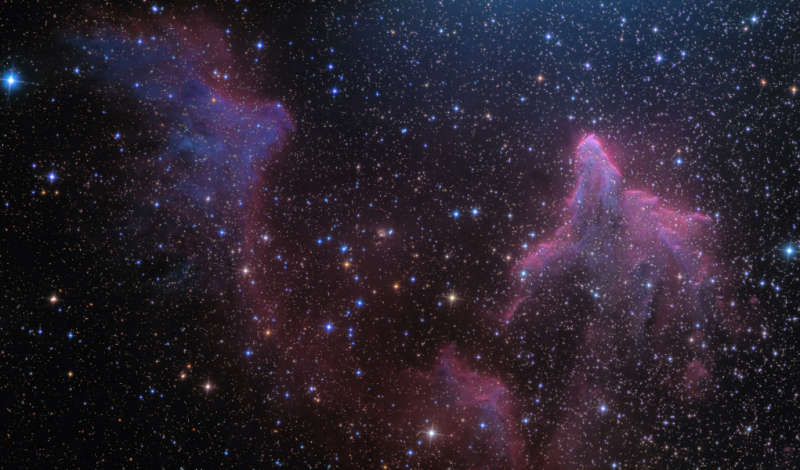Credit & Copyright: Ken Crawford
(Rancho Del Sol Obs.)
Explanation:
These bright rims and flowing shapes suggest to some melting
ice cream on a cosmic scale.
Looking toward the constellation
Cassiopeia,
the colorful (zoomable) skyscape features
the swept back, comet-shaped clouds IC 59 (left) and IC 63.
About 600 light-years distant,
the clouds
aren't actually melting,
but they are slowly dissipating under the influence of
ionizing ultraviolet
radiation from hot,luminous star gamma Cass.
Gamma Cass is
physically located only 3 to 4 light-years from the
nebulae, just off the upper right edge of the frame.
In fact, slightly closer to gamma Cass,
IC 63 is dominated by
red H-alpha light emitted as the
ionized hydrogen atoms recombine with electrons.
Farther from the star, IC 59 shows proportionally less H-alpha
emission but more of the characteristic blue tint of dust
reflected star light.
The field of view spans about 1 degree or 10 light-years at the
estimated distance of
gamma Cass and friends.
1999 2000 2001 2002 2003 2004 2005 2006 2007 2008 2009 2010 2011 2012 2013 2014 2015 2016 2017 2018 2019 2020 2021 2022 2023 2024 2025 |
Январь Февраль Март Апрель Май Июнь Июль Август Сентябрь Октябрь Ноябрь Декабрь |
NASA Web Site Statements, Warnings, and Disclaimers
NASA Official: Jay Norris. Specific rights apply.
A service of: LHEA at NASA / GSFC
& Michigan Tech. U.
|
Публикации с ключевыми словами:
Cassiopeja - reflection nebula - emission nebula - H-alpha - ionization - Кассиопея - отражательные туманности - эмиссионная туманность - ионизация
Публикации со словами: Cassiopeja - reflection nebula - emission nebula - H-alpha - ionization - Кассиопея - отражательные туманности - эмиссионная туманность - ионизация | |
См. также:
Все публикации на ту же тему >> | |
Мнение читателя [1]
